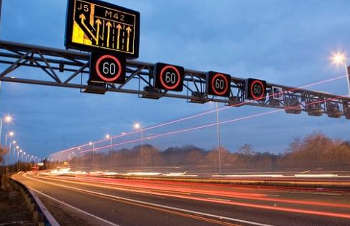Intelligent transportation systems (ITS) are becoming more common and technological advances are pushing things forward all the time. Here are some of the everyday aspects to ITS that are already making your life better and safer on our roads.
1. Allowing speed limits to change depending on variable factors
Until recently speed limits have always been fixed. We see what the speed limit is by looking at the sign by the side of the road. But thanks to intelligent transportation systems, it’s now possible for the authorities to change the speed limit in real-time depending on a set of variables that could affect road use.

Smart highways provide a variable speed limit environment
So, if the conditions change, the speed limit could change. In theory, this can be used in both directions. For example, when conditions worsen, the speed limit can be reduced to make using the road safer for everyone. But when conditions get better and it becomes safer to use the roads at high speeds, the speed limit can be increased. This has the bonus of being able to alleviate congestion too.
2. Alerting drivers of potential dangers ahead
Drivers can be made aware of things that are going on ahead of them on the road thanks to ITS. For example, if there was an accident, the driver could be alerted via bluetooth or another method of communication. They would then be able to decide which route forward they should take to get to their destination.
This is definitely a good thing for road users. How many times have you ended up at the back of a traffic jam wishing you had known about it so that you could have taken the previous exit or diversion? It’s a source of constant frustration for road users, but it might be one that is about to disappear completely thanks to technological developments.
3 Automatic traffic enforcement
Traffic law enforcement can now be done without a police officer having to sit by the side of the road waiting for cars to speed past. Red light cameras can be used to assess whether people are passing through when they should really be stopping. And speed limits can also be monitored. Simple cameras can see how fast you're going, register your license plate and send you a letter.
This helps to cut down on speeding because people know that they can be caught at any time. High-occupancy lanes are for cars with lots of people in them, and these new systems can also monitor whether they are being used in the correct way or being abused.
4 Notifying the emergency services after an accident
This is one of the most beneficial attributes of ITS. When an accident happens on the road, there might not be anyone else around to report it. It is not uncommon for an accident to occur in a remote area or late at night. That means that victims can be left without the help and assistance that they so desperately need.
This problem can now be properly addressed because vehicles are now capable of automatically notifying the emergency services of an accident if the car has this technology on board. That can make the difference between life and death in some situations. It’s a genuine breakthrough in the fight against death on our roads.
5 Vehicle-to-infrastructure communication can help make roads safer
Vehicle-to-infrastructure communication means cars can send data to different sources, which can then be harvested to produce a real-time picture of the network. The more cars get fitted with this new communications equipment, the more people and authorities can be notified of problems and the better our understanding of the safety and traffic flow performance of our roads.
This article was provided by Advance Access Ireland.
Register now for full access
Register just once to get unrestricted, real-time coverage of the issues and challenges facing UK transport and highways engineers.
Full website content includes the latest news, exclusive commentary from leading industry figures and detailed topical analysis of the highways, transportation, environment and place-shaping sectors.
Use the link below to register your details for full, free access.
Already a registered? Login